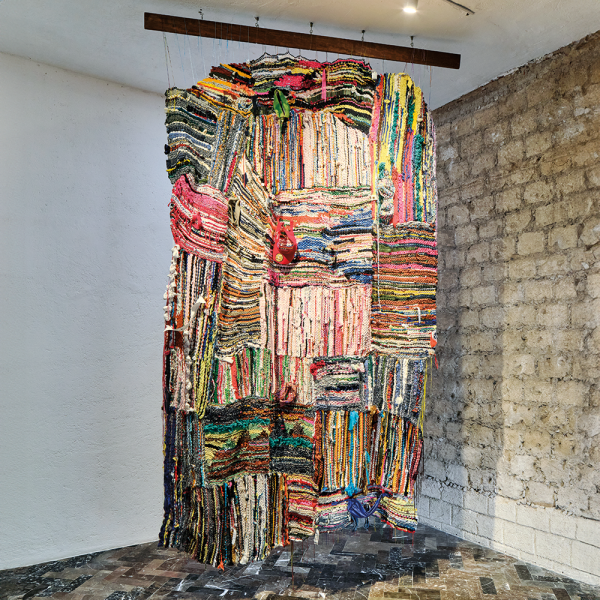Weaving Their Stories
Weaving Their Stories
Mapas started with observation. In 2019, Mayela noticed an increasing number of Venezuelan restaurants and establishments in the city and often heard the accent of her homeland. Interested in why Venezuelans were coming to New York, she stopped people on the street to inquire about their stories. At the same time, the Brooklyn-based artist noted the lack of Venezuelan voices in the news whenever the country’s political and economic crises were discussed.
As of April, more than 7.5 million people had been displaced from Venezuela—the largest forced migration from a Latin American country and one of the most dire humanitarian crises in the world.
In response to what Mayela was witnessing, she issued an open call through social media in 2021, asking Venezuelan migrants in the city to donate sentimental objects that represented their migratory experience. As she received stuffed animals, blankets, kitchen towels, jerseys, work uniforms, and everyday clothing, Mayela recorded the donor’s name, where in Venezuela they migrated from, and the significance of the article that was given.
The artist then cut the textile pieces through the seams to create a patchwork. However, she determined that this method didn’t transmit the message she wanted, so she shifted to using the stretcher frame her husband used for paintings. One night, she hammered nails one inch apart on the top and bottom of the frame and warped it into a loom. Donated items were woven together on this makeshift loom to create a single panel. After removing a completed panel from the loom, Mayela connected it to another to create the larger work Maps of Displacement Vol I: NYC 2021.
With a show scheduled for fall 2021 at Olympia in Manhattan, Mayela knew she wanted to exhibit this new piece. She decided the work would be hung from the ceiling to allow viewers to move around it. On the front side, she maintained identifiable aspects, such as buttons and collars, but the back was flat, showing only the woven texture. Mayela did this intentionally, as she knew that viewers would connect with something familiar. “In a way, I feel, as a migrant, you come with all these things that build your identity or your life and then, in a way, you have to assimilate and shed some of that and turn into something new,” she says. “If you see the front of the piece and then the back, it’s kind of like a clean slate.”

Maps of Displacement Vol II: East Coast 2022 contains fragments from more than 80 people, 123 x 94 x 3 in. Photo courtesy of Olympia and JO-HS.

In the foreground, Mayela’s Healing Color, 2023, was made as a healing gesture to migrants who have donated materials, 48 x 45 in. Photo by apexart.
Originally, Mayela intended to map the individual cities to which Venezuelans were fleeing. But it proved difficult to gather enough donated pieces in a single city, so she decided the second piece in the series would cover a larger area. Maps of Displacement Vol II: East Coast 2022 is composed of fragments received from more than 80 people in Virginia, New York, Florida, Pennsylvania, DC, and New Jersey. The massive textile, which hangs at 123 by 94 by 3 inches, contains splashes of bright yellow, pink, red, orange, and blue in the upper right corner, contrasting with the darker, earthy colors in the lower left corner of the rug-shaped work.
While Mayela’s newer works don’t map the movement of displaced people per se—the artist now combines fragments of donations from Venezuelan migrants with out-of-season items she receives while holding clothing drives to support migrants—she’s still addressing their experiences. Inspired by a friend’s comment on the healing power of the color blue, Mayela created Healing Color, 2023, by sifting through the abundance of blue textile fragments among the piles in her studio. Composed of four vertical panels that are connected at the top and bottom, the 48-by-45-inch installation serves as a healing gesture to migrants who have previously donated materials.
Mayela’s Mapas series offers a pathway to humanize migrants and break away from stereotypes and repeated narratives. Regardless of the iteration, Mayela not only physically weaves donated garments, but she also metaphorically weaves the multitude of stories. It’s impossible to look at one of her tapestries without noticing all the different textile fragments, just as we can’t understand what has taken place in Venezuela without considering the multitude of lived experiences.





